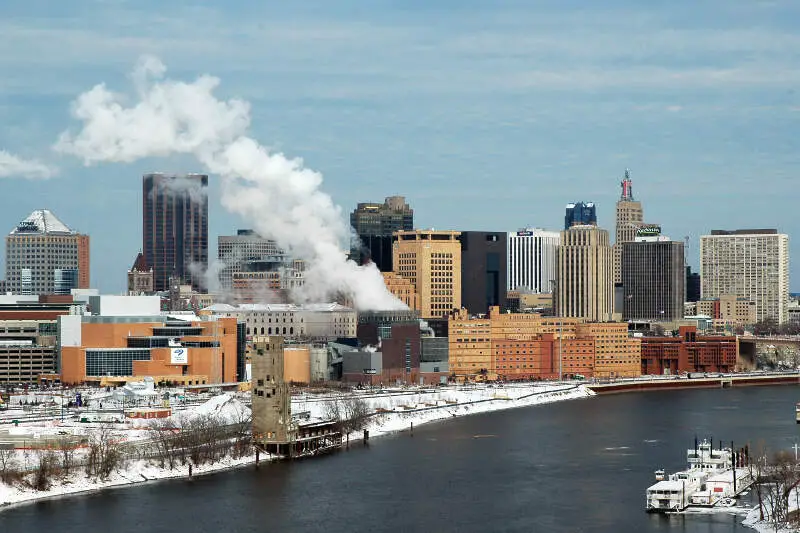St. Paul’s neighborhoods conjure up too many stereotypes to count. You’ve got hipster areas, preppy places, neighborhoods where college kids thrive, and of course, ghettos.
It seems as if there’s a neighborhood for everyone in St. Paul.
And while the city consistently ranks as one of the best places to live in Minnesota thanks in part to tons of entertainment and jobs, it’s not all rainbows and sunshine in St. Paul. Some neighborhoods aren’t as safe as others.
So the question arises, which St. Paul neighborhoods are the most dangerous and which are the safest?
Today, we’ll use Saturday Night Science to determine which St. Paul hoods need a little tender loving care – the sore thumbs of the St. Paul area if you will. Realistically, you can’t expect all the neighborhoods to be amazing, although Utica Square ranks way above the rest.
We examined 15 of St. Paul’s neighborhoods to find out the most dangerous places to live. These places don’t quite measure up to St. Paul’s reputation.
Table Of Contents: Top 10 | Methodology | Summary | Table
So what’s the worst neighborhood to live in St. Paul for 2024? According to the most recent census data, Brady Arts District looks to be the worst neighborhood in St. Paul.
Read on to see how we determined the places around St. Paul that need a pick-me-up. And remember, don’t blame the messenger.
For more Minnesota reading, check out:
- Best Places To Live In Minnesota
- Cheapest Places To Live In Minnesota
- Most Dangerous Cities In Minnesota
The 10 Most Dangerous Neighborhoods In St. Paul For 2024
1. Brady Arts District
Population: 181
Median Home Value: $84,502 (2nd worst)
Median Income: $37,813 (4th worst)
/10
Population: 3,279
Median Home Value: $99,227 (3rd worst)
Median Income: $31,905 (worst)
More on Downtown: Data
3. North Tulsa
Population: 63,592
Median Home Value: $81,020 (worst)
Median Income: $36,327 (3rd worst)
4. West Tulsa
Population: 15,152
Median Home Value: $174,026 (7th worst)
Median Income: $41,704 (5th worst)
5. East Tulsa
Population: 33,252
Median Home Value: $126,233 (5th worst)
Median Income: $43,840 (7th worst)
6. Expo Square
Population: 289
Median Home Value: $112,552 (4th worst)
Median Income: $53,962 (10th worst)
7. Uptown
Population: 318
Median Home Value: $271,375 (12th worst)
Median Income: $32,826 (2nd worst)
8. Burning Tree Housing Addition
Population: 4,188
Median Home Value: $160,146 (6th worst)
Median Income: $42,148 (6th worst)
9. 71 Street Corridor
Population: 1,966
Median Home Value: $182,005 (8th worst)
Median Income: $57,713 (11th worst)
10. South Tulsa
Population: 34,782
Median Home Value: $235,754 (11th worst)
Median Income: $53,207 (8th worst)
Methodology: How we determined the most dangerous St. Paul neighborhoods in 2024
To figure out how bad a place is to live in, we only needed to know what kinds of things people like and then decide what places have the least amount of those things. We plugged the following criteria into Saturday Night Science to get the worst neighborhoods in St. Paul:
- High crime (Estimated)
- High unemployment (Less jobs)
- Low median income (Less pay)
- Low population density (No things to do)
- Low home values (No one’s willing to pay to live here)
Then, we ranked each neighborhood in St. Paul, Minnesota for each of these criteria from worst to best.
Next, we averaged the individual rankings for each criterion into a “Worst Score.”
The neighborhood with the lowest “Worst Score” ranks as the most dangerous neighborhood of St. Paul.
The article is an opinion based on facts and is meant as infotainment. We updated this article for 2024. This report is our time ranking the worst neighborhoods to live in St. Paul.
Skip to the end to see the list of all 15 neighborhoods ranked from worst to best.
Summary: The Worst Neighborhoods Around St. Paul
Well, there you have it — the worst of the neighborhoods in St. Paul with Brady Arts District landing at the bottom of the pack.
The worst neighborhoods in St. Paul are Brady Arts District, Downtown, North Tulsa, West Tulsa, East Tulsa, Expo Square, Uptown, Burning Tree Housing Addition, 71 Street Corridor, and South Tulsa.
As mentioned earlier, the neighborhoods in St. Paul aren’t all bad. Utica Square takes the cake as the best place to live in St. Paul.
The best neighborhoods in St. Paul are Utica Square, Terwilliger Heights, Cherry Street, Midtown, and Southern Hills.
We ranked the neighborhoods from worst to best in the chart below.
For more Minnesota reading, check out:
Most Dangerous Neighborhoods To Live In St. Paul For 2024?
| Rank | Neighborhood | Population | Home Value | Median Income |
|---|---|---|---|---|
| 1 | Brady Arts District | 181 | $84,502 | $37,813 |
| 2 | Downtown | 3,279 | $99,227 | $31,905 |
| 3 | North Tulsa | 63,592 | $81,020 | $36,327 |
| 4 | West Tulsa | 15,152 | $174,026 | $41,704 |
| 5 | East Tulsa | 33,252 | $126,233 | $43,840 |
| 6 | Expo Square | 289 | $112,552 | $53,962 |
| 7 | Uptown | 318 | $271,375 | $32,826 |
| 8 | Burning Tree Housing Addition | 4,188 | $160,146 | $42,148 |
| 9 | 71 Street Corridor | 1,966 | $182,005 | $57,713 |
| 10 | South Tulsa | 34,782 | $235,754 | $53,207 |
| 11 | Southern Hills | 911 | $375,336 | $94,934 |
| 12 | Midtown | 93,629 | $191,452 | $53,389 |
| 13 | Cherry Street | 145 | $207,253 | $59,327 |
| 14 | Terwilliger Heights | 1,141 | $829,351 | $141,396 |
| 15 | Utica Square | 90 | $829,351 | $169,792 |

